Almaz space stations
The Almaz Space Station Program
Sven Grahn
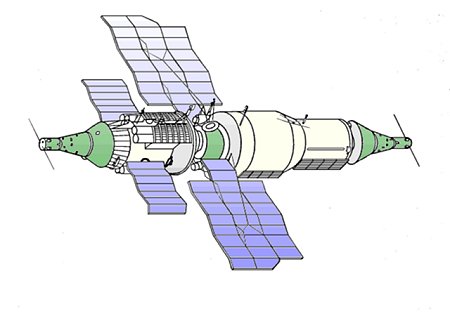 Origins
of the Almaz concept
Origins
of the Almaz concept
The military space station project
Almaz was conceived in 1964 by Vladimir Chelomey's "firm" (currently NPO
Mashinostroyeniya [Machine Building Scientific Production Association])
in the Moscow suburb Reutov. It was indeed a grandiose concept that
impresses even today. A twenty ton spacecraft (OPS) was to have operated
for a couple of years to provide photographic and radar reconnaissance
images. A special supply transport spacecraft, the TKS would arrive at
the spacecraft with cargo and cosmonauts. Its reusable crew capsules
were intended to be reusable up to ten times. Almaz, as originally conceived
can be seen in the sketch on the right.
The plan for launching cosmonauts
to the station changed during the conception of Almaz. The original concept
indeed included the transport craft (TKS), but for a brief period in 1966-67
a variant of the Soyuz would have been the ferry to bring cosmonauts station
(5).
Instead Chelomey proposed to let cosmonauts go into space directly with
the station by adding a large return capsule to the station. each station
would be discarded after the return of the crew. Later, the TKS would be
used to resupply the station with crews. As it turned out, delays in developing
the TKS, led to the decision in 1970 to use a version of the Soyuz 7K-T
ferry to deliver crews to Almaz. This was seen as an interim stage until
the TKS would be ready.
(The design of TKS and the
history of its flight will be the subject of a separate
article under preparation. However, an description of how the Kettering
Group tracked the TKS flights can be found in two articles: "Radio
Observations of TKS and Related Flights", and "Tracking
satellites with a solar radiospectrograph")
The Almaz program was approved
in 1967. However, Chelomey regarded the first launch date in 1970 (on Lenin's
100th birthday) given in the approval decree as unrealistic and argued
that development would require much longer time. In 1969 the requirement
for a prompt "reply" to Apollo prompted the Soviet leadership to give the
Korolev Design Bureau (nowadays Energiya NPO [Scientific Production Association])
the task of launching a space station (17K [DOS]) using some elements from
the Almaz design. Chelomey was ordered to transfer Almaz drawings to Korolev's
Design Bureau. By 1970 eight ground test articles and two flight-rated
Almaz (OPS) "spaceframes" were manufactured by Chelomey's Khrunichev Plant.
However, by the order of MOM these frameworks were passed to Korolev's
Design bureau for implementation of their 17K (DOS) project. In addition,
Chelomey was directed to use Korolev's 7K (Soyuz) spaceships instead of
TKS during flight testing of OPS. The stations developed by
Korolev's bureau based on Almaz used subsystems derived from Korolev's
Soyuz spacecraft and flew first in space starting in 1971 under the name
Salyut-1.
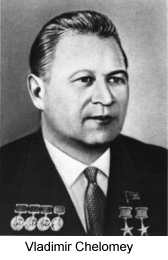 The
transfer of know-how to Korolev's bureau delayed the Almaz program for
two years. Howeveer, this was at the height of the arms race and the Salyut
design of Korolev's design bureau did not have the reconnaisance capabilities
of the Almaz concept. Russian journalists have written (1)
that the Central Committe were taken in by Almaz' as a "space fortress"
which was seen as "a response to Chamberlain" (2).
So the Almaz project continued. The amazing situation developed:
Two Soviet manned station programs were running at the same time.
This confounded Western observers - and indeed myself and the members of
the Kettering group of satellite radio trackers (see
separate article)
The
transfer of know-how to Korolev's bureau delayed the Almaz program for
two years. Howeveer, this was at the height of the arms race and the Salyut
design of Korolev's design bureau did not have the reconnaisance capabilities
of the Almaz concept. Russian journalists have written (1)
that the Central Committe were taken in by Almaz' as a "space fortress"
which was seen as "a response to Chamberlain" (2).
So the Almaz project continued. The amazing situation developed:
Two Soviet manned station programs were running at the same time.
This confounded Western observers - and indeed myself and the members of
the Kettering group of satellite radio trackers (see
separate article)
That Almaz was seen indeed
a military spacecraft - a "fortress in space" can be inferred from the
persistent reports that these stations were equipped with weapons:
-
"Almaz was protected against
interceptor and tow satellites, been developed back then in the USA. OPS
[Orbital Piloted Station] was equipped with high speed aviation 23 mm cannon
by A.Nudelmann KB. The gun was pointed to the target by revolving the whole
station. This weapon proved to work in space environment. In one of flights,
just before the braking impulse to the station, flying automatically, the
gun ammo was shot out. The cannon fired accurately, and all the constructions
appeared reliable and rigid. " (3)
-
"I was told by a friend, that
he was told by cosmonaut Popovich (commander of Soyuz 14 aboard Salyut
3) that the cannon did exist on his flight, but very fortunately he was
not forced to use it. Obviously, the cannon was not present aboard Salyut
5. In N. Kidger: Almaz - A Diamond out of Darkness, Spaceflight, March
1994, pp. 86 - 89, cosmonaut Lisun (back-up flight engineer for Salyut
5) is cited definitely denying the existence of such a cannon aboard the
Almaz stations in space. " (4)
Almaz
design features
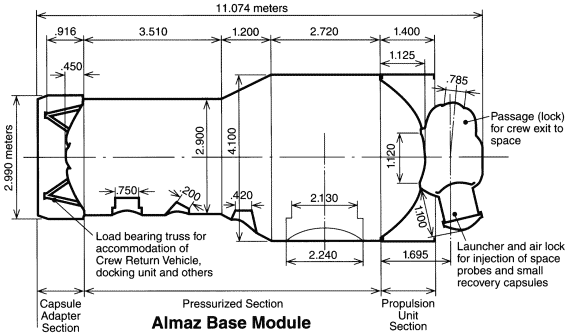
Dimensions
and mass
The basic space station block
was shaped like a cylinder with two two different diameters, 4.15 m and
2.9 m. Its total length was about 11 meters. (See sketch above (10)).
Its mass was about 15 tons. In the original version, foreseen to be launched
after the initial stations, the Return Apparatus (VA) re-entry vehicle
would be connected to the smaller diameter section of the station. A docking
unit was mounted at the rear of the station along the axis of the station.
The docking unit was connected to an airlock for extra-vehicular activity
and for ejecting the so-called Information Return Capsule (KSI).
Power
and propulsion
Two solar panels were mounted
at the rear of station generating 3.1 kW, having a span of 23 meters and
an area of 52 square meters. At the rear of the station there were two
orbit correction engines with a thrust of about 4000 N each. These engines
were mounted on each side of the docking unit. (See an aft
view of the docking unit and orbit correction engines).
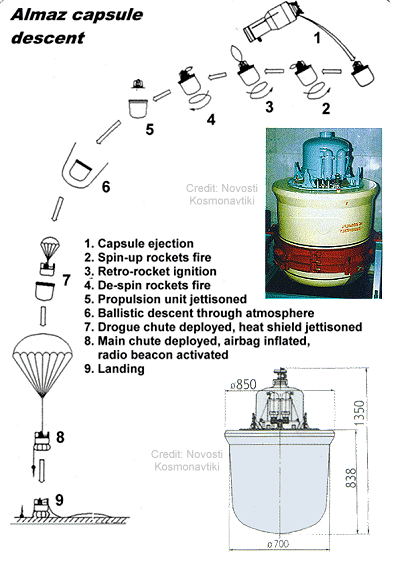 The
Information return capsule
The
Information return capsule
The Information return capsule
(KSI) could return film from the main reconnaissance camera (Agat-1). The
capsule had a mass of about 360 kg and a diameter of 0.85 m. After ejection
from the space station it was spun up by a small solid rocket motor. Then
the main retro rocket fired and after burnout another small solid rocket
fired to de-spin the capsule. The rocket motor pack was jettisoned before
reentry. Before landing the drogue cute pulled the capsule out of the heat
shield. An airbag was inflated to cushion the landing.
The
Agat-1 reconnaissance camera and its radio link
A colossal telescope, the Agat-1,
approximately one meter in diameter and with a focal length of 6.4 meters,
was mounted in the station's "floor". The crew could photograph targets
such as airfields and missile complexes using the telescope. An optical
sight permitted them to "come to a standstill" over a facility.
Furthermore, there was a device for taking pictures in the near infrared
range and a topographical camera. The film frames were quite large, 50
x 50 cm and according to U.S. estimates would have had a resolution of
less than 50 cm. We can check this estimate of the capability of the camera
by assuming that the film used was as good as that used by early version
of the the U.S. CORONA satellite,. i.e. the film was capable of resolving
100 line pairs per millimeter (8).
The formula below is a very
simple relationship between orbital altitude (h), ground resolution (r),
focal length (f), and film resolution (p).
p/f=r/h or r= h × p/f
For Almaz h = 270 000 m and
f = 6.3 m. So, let us assume that the film used in the Agat-1 camera had
the same resolution as the used in early CORONA flights, i.e. 100 line
pairs per millimeter. This means that two dark lines 1/100 mm apart with
a lighter area in between can be resolved by the film if properly exposed
and if proper ground motion compensation was implemented. The film resolution
p can the be written: p = (1/1000) × (1/100) and the ground resolution
becomes:
r = (270000/(100000 ×
6.3)) = 27/63 = 3/7 = 0.43 m
Later CORONA flights had
a resolution of 160 line pairs per millimeter, which would have corresponded
to a ground resolution of 0.27 m..
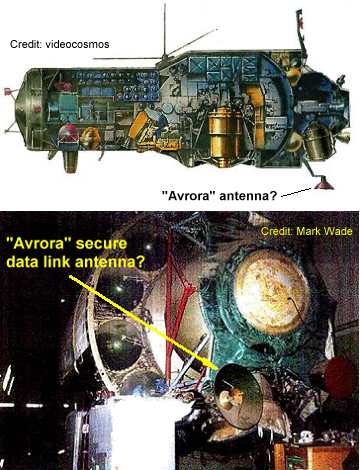 The
minimum aperture diameter (D) required to satisfy the diffraction limit
criterion for the Agat-1 telescope can be estimated by the following formula:
The
minimum aperture diameter (D) required to satisfy the diffraction limit
criterion for the Agat-1 telescope can be estimated by the following formula:
D = 1.22 × L ×
f/p
where L is the average wavelength
of the film sensitivity, here assumed to 0.5 micrometer.
D = 1.22 ×0.5 ×
10-6 × 6.3 × 105 = 0.4 m
We know that the aperture
diameter was five times large about 2 meters, which was probably dictated
by the required signal to noise ratio and the chosen exposure time.
Data from this reconnaissance
payload on Almaz could be returned not only via the KSI, but also through
a radio link to the ground. It seems that film from the reconnaissance
cameras would be developed on board, scanned and transmitted to the ground
- all within 30 minutes (5). Considering
the secret nature of the Almaz program and the Soviet obsession with secrecy
the downlink for the reconnaissance pictures the downlink must have been
designed to be secure. In addition to encryption it seems natural that
some kind of directional antenna would have been used. When I looked through
pictures of Almaz that I had downloaded to my computer I kept an eye out
for such an antenna. I think I have been able to identify a good candidate
for the antenna system of the secure data link called "Avrora"(5).
The picture on the right
shows two independent views of the Almaz base block and there is a small
dish antenna, with a diameter of about 0.7 meters, near the rear part of
the 4.15 m cylindrical section. If the frequency 10 GHz was used the beamwidth
of this antenna would have been about 3 degrees, which would have resulted
in a coverage are on the ground of about 15 × 30 km at 30 degrees
elevation. Clearly, this was a small enough area to avoid eavesdropping.
However, the dish antenna had to be steered to point at the ground station.
Radio
systems
As described elsewhere the Kettering
Group was ale to distinguish between Almaz and DOS stations by observing
radio signals from the various flights in the Salyut program. Just like
the DOS station's developed by "OKB-1" Almaz had a short-wave telemetry
transmitter, called "support" telemetry by the Russians (see
below).
Just like DOS Almaz had a VHF transmitter for the main telemetry system.
However, the command uplink and command verification downlink systems were
completely different. DOS used the command system on Soyuz, similar to
the "Kvant" system nowadays used on the ISS (Zvezda), while Almaz probably
used the Komparus system used by military spacecraft and also the
FGB (Zarya) on the ISS. The FM voice downlink turned out to be different
for the two stations, but frequencies used were among those used for Russian
manned spaceflight over four decades. The table below summarizes the frequencies
used by Almaz (OPS) and DOS.
| Function |
OPS (Almaz) |
DOS |
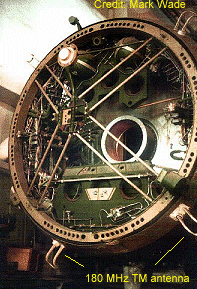 |
| Support telemetry |
19.944 MHz (FSK-PDM)
19.992 MHz (?) |
15.008 MHz (CW-PDM)
(Sal. 1,4,6,7)
20.008 MHz (CW-PDM)
(Sal. 1,4,6,7) |
| Main telemetry |
181.0/180.0 MHz (PPM-AM) |
192.0 MHz (PPM-AM)
(Sal. 4,6,7)
166.0 MHz (PPM-AM)
(Sal. 7) |
| Main voice link |
143.625 MHz |
121.75 MHz Salyut 4,6
142.417 MHz Salyut 7 |
| Command system |
2365-2375 MHz down?
7190-7210 MHz up? |
922.754 MHz down
768.96 MHz up |
| Radar transponder |
? |
2802 - 2860 MHz down
2725 MHz up |
The 180 MHz telemetry antennas
can easily be located on the Almaz base block. Four folded dipoles are
located on the VA capsule adapter section at the front of the station as
shown in the picture on the right side of the table. The shortwave "support"
telemetry antennas can be found on the cone connection the main 4.15 m
diameter cylinder and the smaller diameter section of the station.
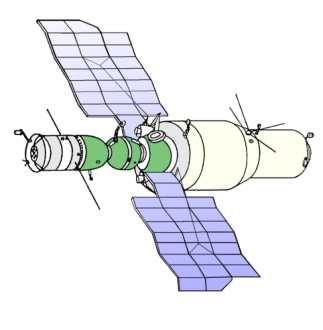 Scaled
back Almaz for flight testing
Scaled
back Almaz for flight testing
To be able to test Almaz without
either the TKS or the VA ready, the Almaz base block was launched without
the VA and the Soyuz ferry was used to transfer cosmonauts to the station.
The scaled-back Almaz probably did not carry the side-looking radar of
the full-scale station, even though strange white wedges on the smaller
diameter part of the base block resemble antenna structures (see below).
This scaled-back version of the station was launched three times; OPS-1,
No. 101 as Salyut-2 on 3 April 1973, OPS-2, No. 101-2 as Salyut-3 on 24
June 1974 Jun 24, and OPS-3 No. 103 as Salyut-5 on 22 June 1976. In 1978
flight testing of OPS was completed and the Ministry of Defense decided
not to accept it for operational service (as inferior to automatic reconnaissance
satellites).
The
first launch of Almaz - Salyut-2
The first Almaz that was launched
was called Salyut-2 was launched into orbit at 0900 UT on 3 April 1973.
It maneuverd to an orbit with a 63-rev repeating apttern within five days
of the launch. Clearly, the orbit established at 89.8 minutes was
stable enough to let the space station wait in orbit until the Soyuz was
ready to launch. The Soyuz craft to be used for ferrying cosmonauts
to the station was still undergoing parachute tests and the sattion had
been launched so that it would be in the right position to received a crew
about a month after launch (5). While the
crew was preparing to launch to it a disaster occurred at some time between
0930 UT on 14 April and 0016 UT on 15 April, when the station was out of
line-of-sight touch with Soviet ground stations. According to (5)
there was no main telemetry (presumably the 181 MHz link, see below)
from the station when it appeared over Ussuriysk at 0016 UT on 15 April
and "support" telemetry (presumably the 19.944
MHz shortwave transmitter, see below) indicated
that the pressure had dropped to half inside the station. Soviet tracking
data also showed a slight increase in the orbital period. In the figure
"Salyut-2 maneuvers below" there is a slight increase in the period on
day 105 and the rate of decay suddenly increased, indicating that the spacecraft
had started to tumble instead of being oriented "nose first". Reports in
Western media indicated the station tumbled at a rate of 30 rpm.(6)
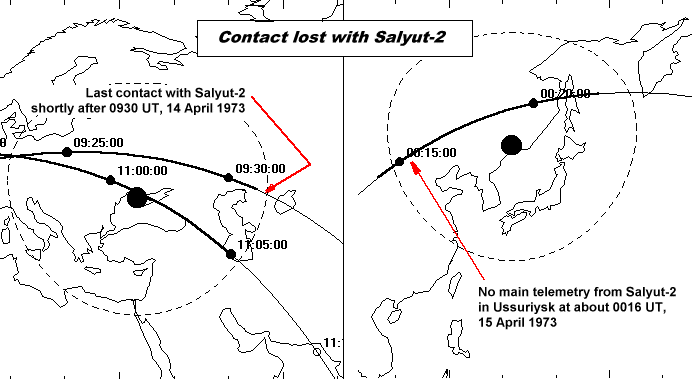
The offcial reason for the
failure seems to put the blame on the propulsion system causing the rupture
of the hull, even though the explanation provided is somewhat difficult
to interpret. It seems to indicate a "stuck thruster" (5):
"...led
to a continuous working of the low-thrust stabilization engines and significantly
increased its temperature, that caused overheating..." This
explanation is also cited by a a Western source at the time (6).
Another theory advanced by engineers in Chelomey's organisation was that
a fragment of the exploded Proton's third stage penetrated the skin of
the space station.
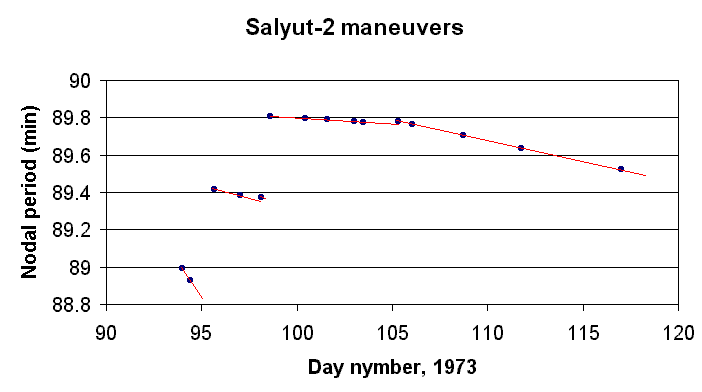
If one examines the first twenty
days in orbit one can see that maneuvers ceased after day 105, i.e. 15
April. The station decayed from orbit on 28 May 1973.
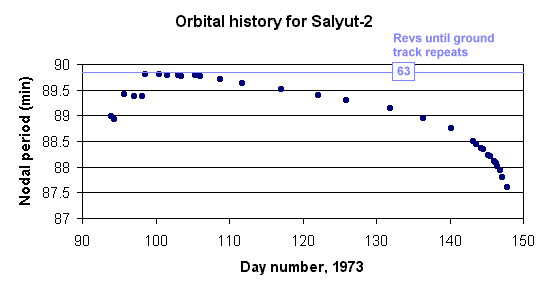 Phillip Clark has developed
a method for predicting "landing windows" from early Salyut stations (11).
The method uses the number of hours before local sunset at the landing
point that the northbound equator crossing that put the spacecraft
nearest the landing zone occurs. The diagram below uses data from Soyuz
14 and 24 because these missions flew the entire planned duration. A "landing
window" for descent from the station opened around day 143, i.e. 23 May,
when the equator crossing occurred about 3.8 hours before local sunset
in the recovery zone. (this calculation assumes an orbit with the decay
rate that Salyut-2 had before the catastrophe on 14 April). So a if 14-day
flight had been planned would have meant a launch around 7-9 May. It seems
that the flight was actually planned for 8 May (5).
Phillip Clark has developed
a method for predicting "landing windows" from early Salyut stations (11).
The method uses the number of hours before local sunset at the landing
point that the northbound equator crossing that put the spacecraft
nearest the landing zone occurs. The diagram below uses data from Soyuz
14 and 24 because these missions flew the entire planned duration. A "landing
window" for descent from the station opened around day 143, i.e. 23 May,
when the equator crossing occurred about 3.8 hours before local sunset
in the recovery zone. (this calculation assumes an orbit with the decay
rate that Salyut-2 had before the catastrophe on 14 April). So a if 14-day
flight had been planned would have meant a launch around 7-9 May. It seems
that the flight was actually planned for 8 May (5).
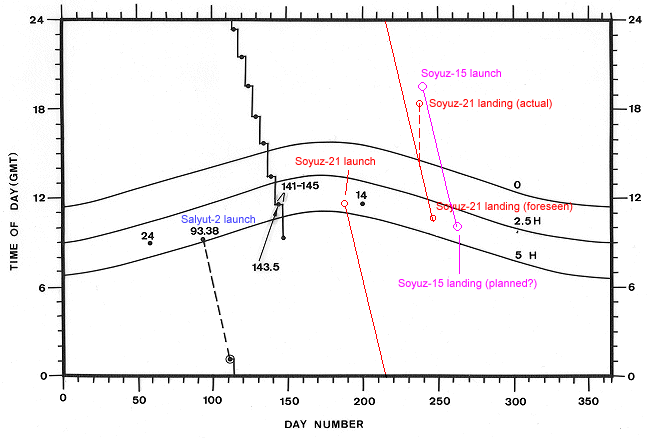
The
first succesful Almaz - Salyut-3
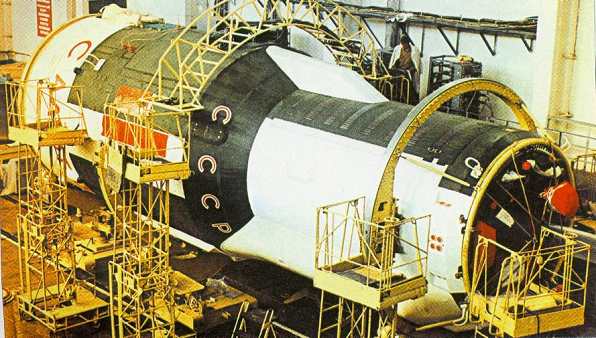 Salyut-3,
another Almaz (OPS No 0102), was launched into space from launch
site 81L at Baikonur at 2238 UT on 24 June 1974. The picture on the
right shows Salyut-3 in the checkout shop (at Baikonur?) (9).
Interestingly it is labeled "Salyut" at the base. As can be seen in the
graph of nodal period as a function of date for Salyut-3 during 1974 the
Soyuz-14 ferry with cosmonauts Popovich and Artyukhin was launched when
the space station had set up on orbit that almost exactly repeated every
four days. In this way, launch opportunities to rendezvous and dock withn
the station occured every four days. It took the station 9 days to reach
this orbital altitude.
Salyut-3,
another Almaz (OPS No 0102), was launched into space from launch
site 81L at Baikonur at 2238 UT on 24 June 1974. The picture on the
right shows Salyut-3 in the checkout shop (at Baikonur?) (9).
Interestingly it is labeled "Salyut" at the base. As can be seen in the
graph of nodal period as a function of date for Salyut-3 during 1974 the
Soyuz-14 ferry with cosmonauts Popovich and Artyukhin was launched when
the space station had set up on orbit that almost exactly repeated every
four days. In this way, launch opportunities to rendezvous and dock withn
the station occured every four days. It took the station 9 days to reach
this orbital altitude.
An additional factor important
for launching a ferry to Almaz was the equator crossing longitude for the
space station revolution passing nearest the launch site. If a direct ascent
(within a few revolutions) is made to the space station, the longitude
of the station equator crossing should be very close to that of a Soyuz
launched form Baikonur. Soyuz ferries to early space stations used about
one day to reach the station. The altitude of the ferry would be gradually
raised to coincide with that of the station. The higher up the station
is the larger is the average is the difference in orbital altutde during
the rendezvous phase between the ferry and the station. Thus, to reach
the station after 24 hours, the initial phase difference along the
orbit between the ferry and the station need to be larger the higher up
the station is. But to let the orbital planes coincide at launch the equator
crossing longitude of the station at the revolution passing closest to
the launch site on the day of the launch of the ferry needs to be further
east the higher the station is. In that way the proper orbital phasing
is achieved when the station's orbital plane drifts westward until the
time the ferry is launched. A graph showing this relationship can be seen
in a separate article.
Thus, when Soyuz-14
was launched at 1851:08 UT on 3 July 1974 (Day nr: 184), the equator crossing
for the Salyut-3 station was 345.15 degrees west. The crew came down on
19 July 1974 (Day nr: 200) which was according to plan if one considers
the "landing window" criterion developed by Phillip
Clark. Thus, the first visit on board Almaz lasted 14 days. Radio tracking
efforts by the Kettering
Group during the flight of Soyuz-14 is covered in a
special article at this web site.
Soyuz-15 was
launched at 1958:08 UT on 26 August 1974 (Day nr: 238). The orbital period
of the space station had again been brought up close to the period which
yields a ground track that repeats every 63 revolutions, i.e. every four
days (see figure showing the "orbital history" below). The Soyuz failed
to dock with Salyut-3 and was recovered on 28 August 1974 (Day nr: 240).
The IGLA
system malfunctioned and the two craft missed each other by a mere
7 meters on the first attempt and 30-50 meters on the second. If one applies
the same "landing window" analysis as for Salyut-2
it seems that the flight could have ended around day 261 (18 Sept 1974)
which would have meant a 20-21 day stay on Salyut-3. Indeed, in (5)
Soviet sources are quoted as indicating that a 25-day flight was planned.
In the figure below the time
when the film capsule (KSI) was ejected from Salyut-3 (19 September). It
turns out that the recovery of the KSI also satisfies Phillip Clarke's
"landing window" criterion. In the diagram below the maneuver to a 63-rev
repeating pattern has been indictaed. This could have been in anticipation
of another Soyuz launch attempt, but it was probably done to keep the station
from decaying and to permit further testst in the unmmaned mode. Salyut-3
was de-orbited intentionally over the Pacific on 24 January 1975. The first
Almaz mission was over.
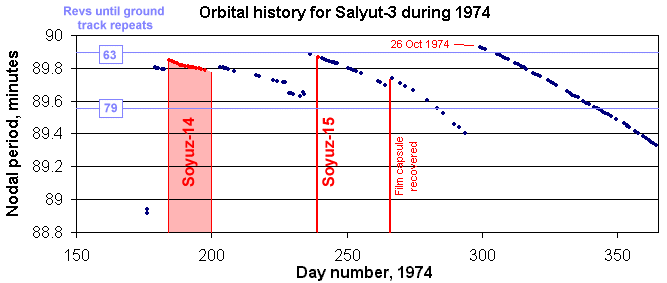
The
final Almaz station - Salyut-5
Salyut-5 was launched at 1804
UT on 22 June 1976. It quickly maneuvered to the 63-rev repeating
pattern orbit of its predecessor Salyut-3. In a similar fashion a ferry
with cosmonauts, Soyuz-21, was launched as soon as that orbit
was reached. So, Soyuz-21 was launched on 1208:45 UT on 6 July 1976 (Day
nr: 188). By again using the "landing windows" analysis developed by Phillip
Clark it seems that landing was planned around day 245, i.e. 1 September
1976. The flight actually ended on day 237, i.e. 24 August 1976 when the
Boris Volynov and Vitali Zholobov touched down at 1832:17 UT. There have
been reports (12) that the flight ended
early due to crew psychological problems ("interpersonal issues"), but
transcripts
of the voice signals from the station show no such signs. Indeed, the
flight seems to have ended a little early, and perhaps crew status could
have been a factor in this decision. Absence of evidence is not the same
as evidence of absence! Other sources (11)
have indicated that the cabin atmosphere was contaminated.
Soyuz-23 launched
at 1738:18 UT on 14 October 1976 (Day nr: 288) with V Zudov and V Rozdestvensky
was launched. This was at a time when Salyut-5 was in an orbit whose ground
track repeated every 9 days (142 revs)! The docking failed and the
crew landed at1745:13 UT on 16 October 1976 (Day nr 290). Clark writes
(11) that a flight duration of 17-24 days
is possible based on "landing window" analysis.
Regular telemetry from the
Salyut-5 space station on 180 MHz resumed on 2 February 2, 1977 indicating
that a Soyuz launch might be imminent. Soyuz-24 was launched
at 1611:50 UT on 7 February 1977 (Day nr: 38). The crew (Viktor Gorbatko
and Yuri Glazkov) was supposed to have been wearing breathing masks upon
entry into the station (11). This could be
an indication that the reports about a foul cabin atmosphere were true.
However, the flight proceeded for 18 days and ended at 0936 UT on 25 February
1977(Day nr: 56 ).
The film return capsule (KSI)
from Salyut-5 was recovered on 26 February 1977, directly after the return
of the Soyuz 24 crew. Salyut-5, the last Almaz space station, burned up
in the Earth's atmosphere on August 8, 1977 as can be seen in the graph
below where the orbital period plunges towards oblivion requiring only
a small rocket nudge to bring it do de-orbit.
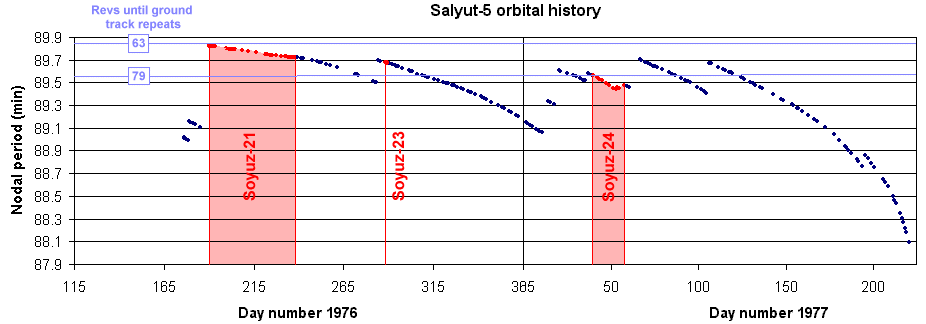
References
-
Moscow
Komsomolskaya Pravda in Russian 21 Nov 98 p 3, Article by Aleksandr
Milkus, under the rubric: Secret : Almaz - The Murderer Looked
Into the Statue of Liberty's Eyes Three Times - Few People, Even Among
Those Who Said Goodbye Yesterday at Baykonur, Knew That This Functional-Cargo
Unit Had an Fearsome Classified Ancestor: Zarya - The International
Space Station's First Module A Military Space Fortress - That's What the
Central Committee Viewed as a Response to Chamberlain.
-
Constantine
Domashnev, e-mail to FPSPACE listserver: "Our Response to Chamberlain"
is a metaphor. It means is a response to a mean freak, which cannot be
tolerated. Neville Chamberlain was a British politician, Conservative,
a member of Parliament since 1915, a member of Government in the 20 ths,
later Britain's Prime Minister. Chamberlain as you can guess was a radical
anti-Communist and an enemy of the Soviet Union. So, at some point of his
career, he called for Crusade against USSR or something. In USSR, his call
was heard and broadcast to the public. The Soviet public was supposed to
respond appropriately. The meaning of the phrase "a Response to Chamberlain"
is known to probably every Russian because of a famous humorous book describing
Russia in those years. This book provided one example of such a response
to Chamberlain.
-
Igor
Marinin, Sergej Shamsutdinov: "Almazs" for the Proletariat Dictatorship,
Air Fleet Herald (on Russian) 5/6 1995, page 89-91(The title alludes to
the "Diamonds for the Proletariat Dictatorship" movie)
-
E-mail
to FPSPACE listserver from Dietrich Haeseler (1998)
-
Asif
A. Siddiqi: The Almaz Space Station Complex: A History, 1964-1992,
part 1, JBIS, Vol 54, No 11/12, November/Ddecember 2001.
-
Aviation
Week,14 May 1973, "Reaction Controls Cited in Salyut Breakup"
-
Russian
Space History, catalogue of the auction at Sotheby's sale 6516 in
New York, 11 December 1993, item. 154.
-
Robert
A. McDonald ed., CORONA between the Sun & the Earth, the first
NRO reconnaissance eye in the sky, American Society for Photogrammetry
and Remote Sensing, Bethesda, MD, 1997, ISBN 1-57083-041-X, pp. 189-190.
-
Vassily
Omelko ed., "Baikonur Kosmodrom", Rosaviakosmos, Moscow, OMV-Luch NPP,
2000, 224 p, found by Dietrich Haeseler
-
"The
Almaz modules: Providing New Avenues for Space Commerce...", a brochure
published by the Space Development Corporation (1331 Gemini Ave., Suite
310, Houston, TX, USA
77058).
-
Phillip
Clark, "The Soviet Manned Space program: An Illustrated History of
the Men, the Missions, and the Spacecraft", New York: Orion, 1988, p.62
-
Bryan
Burrough, "Dragonfly, NASA and the crisis aboard Mir", HarperCollins,
1998, p.185.

 Back
to Space Tracking Notes
Back
to Space Tracking Notes
The
transfer of know-how to Korolev's bureau delayed the Almaz program for
two years. Howeveer, this was at the height of the arms race and the Salyut
design of Korolev's design bureau did not have the reconnaisance capabilities
of the Almaz concept. Russian journalists have written (1)
that the Central Committe were taken in by Almaz' as a "space fortress"
which was seen as "a response to Chamberlain" (2).
So the Almaz project continued. The amazing situation developed:
Two Soviet manned station programs were running at the same time.
This confounded Western observers - and indeed myself and the members of
the Kettering group of satellite radio trackers (see
separate article)
The
minimum aperture diameter (D) required to satisfy the diffraction limit
criterion for the Agat-1 telescope can be estimated by the following formula: